The Genesis GV80 does not have a V8, as its name seems to suggest it might. But it does have something else that’s getting hard to find in a crossover SUV – especially in something that costs less than $50,000 to start.
Rear-wheel-drive.
Unlike most of the other models in its class – like the Lexus RX, the Acura MDX and the Audi Q5 – which are built on front-wheel-drive layouts. That’s not necessarily a bad thing, depending on your priorities. FWD is without doubt grippier than rear-wheel-drive, making it less necessary to spend extra to get all-wheel-drive (or four-wheel drive) if you have to deal with slippery conditions.
But rear drive is a good thing, too – if you prefer the better handling feel that usually comes with having the front wheels steer while the rear wheels power. The rear-drive layout is also generally more rugged because the work of steering and powering is not handled by the same pair of wheels – or a single transaxle.
You can also usually pull a heavier load for that reason, too – almost 8,000 lbs. in this case.
Which is several thousand pounds more than FWD-based rivals in the segment like the Lexus RX350 and Acura MDX – and also more than more expensive rear-drive-based rivals like the BMW X5 and Lincoln Aviator, too.
The GV80 is the first crossover to be sold by Hyundai’s Genesis luxury division. It is built on a modified version of the Genesis G80 sedan’s underlying chassis but seats up to seven rather than just five.
It is also one of just a few of its kind that isn’t built on a light-duty, FWD chassis – like most cars. Instead, it is built on a rear-drive chassis, like the G80 sport sedan. Which makes it sportier than FWD-based crossovers – as well as more capable of pulling a heavy load.
While also being just as capable in the snow or mud, if ordered with its available AWD system.
It comes with either of two turbocharged engines- neither of them a V8 but both making what was not too long ago considered V8 power. And in some cases, more power than some current V8s make.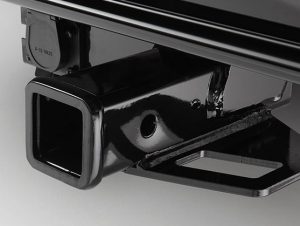
Even the four can pull 6,000 pounds.
Prices start at $48,900 for the base 2.5T trim, which comes with a turbocharged 2.5 liter engine that makes 300 horsepower, an eight speed automatic and rear-wheel-drive.
AWD is available as an option bundled with key card ignition/entry system, a panorama sunroof and heated steering wheel.
It lists for $54,650.
A top-of-the-line 3.5T Advanced+ comes with a 375 horsepower turbocharged V6, the eight-speed automatic, a power-folding third row, heated second row and standard AWD.
It lists for $65,550.
The GV80 is a new model for Genesis – and the first crossover SUV to be offered by Hyundai’s flagship division.
What’s Good
Tows like a truck – even with the standard four cylinder engine – but doesn’t handle like a truck.
Standard four is stronger than some rivals’ sixes;optional V6 outpowers some V8s.
AWD is available with the four; some rivals upsell you to the optional six to get the optional AWD.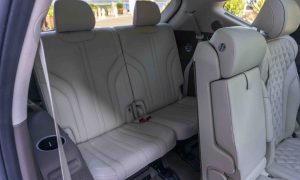
What’s Not So Good
AWD is “bundled” as part of an expensive package that boosts the GV80’s price by nearly $6k.
No Low range gearing.
Third row is only available with the top-of-the-line Advanced+ trim.
Under The Hood
A funny thing about the GV80’s standard and available engines. Both make about as much power as V8 engines used to make – and both deliver about the same gas mileage that V8s used to, too.
The chief difference is how they make power. Instead of displacement – physical size – via pressure, as by turbocharging. Which uses the force of exhaust gasses to spin a wheel (two, if there are twin turbos) that compresses – pressurizes – the air entering the cylinders, so as to make the resultant explosion more powerful.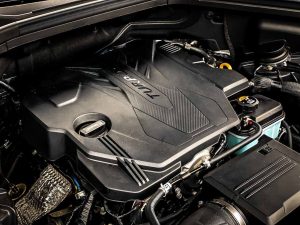
This is how you get a four cylinder engine that’s only 2.5 liters in size to make 300 horsepower – and 311 ft.-lbs. of torque at just 1,650 RPM and a V6 that’s only 3.5 liters large to make 375 horsepower and 391 ft.-lbs. of torque at 1,300 RPM.
These numbers would have been thought good numbers for a V8 around 4.6 liters in size about a decade or so ago. Or a 5.3 V8 today (hang on a minute).
Well, why not just got with a V8 around 4.6 liters in size or so?
Two reasons, one political the other practical.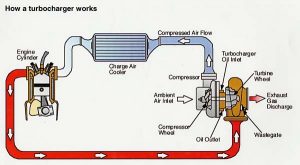
A V8 is physically larger than a V6 and much larger than a four. It is harder to fit a V8 in an mid-sized vehicle’s engine compartment where there’s plenty of space for a four and just barely enough space for a V6, as is the case with vehicles the size of the GV80. The engine compartment would have to be reconfigured and then the passenger cabin would have to be reconfigured, to make up for the room taken up by the larger engine and everything bolted to it.
But the real reason is political.
V8s use “too much” gas . . . for the government’s liking. They also emit more gas – carbon dioxide – than is becoming acceptable . . . to the government. In theory, you can reduce both gas consumption and gas emissions by using a smaller engine, which will generally burn less fuel (and so emit less gas) than a larger one.
The turbo(s) make up for the power lost – when power is wanted . . . by the driver.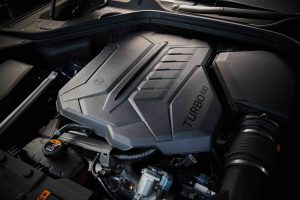
But this is largely a dog-and-pony show because most drivers will need the turbo-boosted power – to make up for the engine’s smallness in proportion to the size and weight of the vehicle and so the engine will be turbocharging – on boost – often enough to end up delivering not much better-than-V8 mileage, in this case 21 city, 25 highway for the four and 18 city, 23 highway for the V6.
Which is about what V8s in the 4.6 liters range were delivering about ten years ago. Maybe a little better – on paper – but not much. And not if you keep your foot in it.
But at least the power – and torque – is still there.
And the GV80 has more of it – standard – than several rivals, such as the Lexus RX350 (3.5 liter V6, 290 hp) and Acura MDX (3.5 liter V6, 295 hp) that don’t offer more power. One that does offer more power as standard is the Lincoln Aviator, which comes equipped with a 400 horsepower 3.0 liter turbocharged V6 – but in spite of its muscle, it can only tow a maximum of 6,700 lbs.
The base four cylinder GV80 can pull almost as much – 6,000 lbs. – and if you go with the optional V6, the maximum tow rating climbs to 7,700 lbs. This is more than twice as much as the Lexus RX350 can pull (3,500 lbs.) and substantially more than the Audi Q5 (4,400 lbs.) and the Acura MDX (5,000 lbs.) can safely handle.
Part of the reason for this pulling-power advantage is probably the GV80’s rear-drive-based layout, which usually means a stronger underlying frame/chassis that can handle the stress of pulling a heavier load without bending. Also the transmission and separate axle in the rear – vs. the usual transaxle (a combination of the transmission and axle into a single unit) up front, as in FWD-based vehicles.
Regardless, the GV80 tows a lot. Almost as much as several truck-based (and much larger) SUVs like the Chevy Tahoe, which can pull a comparatively unimpressive 8,400 lbs. – given the 5.3 liter V8 under the Tahoe’s hood. Which only makes 355 horsepower – less than than the GV80’s 3.5 liter V6.
The Tahoe’s larger/less powerful V8 also uses more gas – though not much more. It rates 16 city, 20 highway – a difference of about 5 MPG vs. the GV80’s V6.
Assuming you keep your foot out of it.
On The Road
There isn’t much difference between the four and the six when it comes to how quickly the GV80 gets to 60. With the base 2.5 liter engine/RWD combo, it takes about 6.5 seconds; if you go with the V6 – which is heavier because it comes standard with AWD – you’ll get there about half a second sooner.
It’s not a very noticeable difference – and it’s not as quick, with either engine, as some of the others in the class. Including – interestingly enough – models like the Lexus RX350 that aren’t as mighty on paper but are a little bit quicker out in the world.
Both engines have one thing in common: Diesel-like low-end power. Even the four has 300-plus ft.-lbs. of torque on tap and the six has 391 ft.-lbs., which is more torque than the much larger 5.3 liter V8 in the Chevy Tahoe produces (383 ft.-lbs.) and much lower down on the tachometer – just 1,650 RPM vs. 4,100 RPM for the Tahoe’s V8. 
What this means in practical terms is that the GV80’s not-V8s feel less hard-working than V8s like the 5.3 in the Tahoe, which need to rev to summon their gumption. The GV80 – even with the four under its hood – moves authoritatively with minimal throttle pressure; in traffic it is an extremely easygoing engine.
On the highway, with the revs up, it starts to sweat a little – but once settled into the eight-speed automatic’s very deep overdrive, it doesn’t struggle to maintain a cruise-controlled 75-80 MPH, which is pretty impressive given it’s just 2.5 liters hauling 4,700 pounds of GV80.
Plus you.
The V6 has even more down-low gumption with the additional perk of more authoritative thrust on the highway. This – plus the ability to tow a heavier load – are the main reasons to opt for the larger engine and the choice to upgrade is made easier given the mileage difference between the four and the six is only about 3 MPG either way.
The biggest difference is, of course, the price – which rises dramatically to get the six. Part of the reason for that probably being due to the fact that it comes only with the AWD system. On the other hand, you can get the four with or without the AWD system. In other words, Genesis doesn’t force-upsell you to the six in order to get the AWD. Which also means you can stick with rear-drive, if you prefer. Some in the class, like the Audi Q5, come only with AWD – which also means they cost more than the rear-drive version of the GV80.
AWD does provide additional traction, but rear-drive can be more fun – because it’s easier to break traction. Not that many prospective buyers of a first-class mobile lounge such as the GV80 are prone to such reversions to the high school parking lot burnout . . . but it can be nice to know you could.
Either way, the GV80 comes standard with 8.1 inches of clearance, which is just as critical and can be even more so than traction, in the weather. You can’t get through what you can’t ride over.
It’s said – and it’s true – that crossovers have become far more popular than sedans because they are so much more practical than sedans, including sedans that are roughly the same overall size.
This is no less true of the GV80 – which is based on the Genesis G80 sedan. And looks it. Notice the commonality of the grille and detail items such as the twin-slat LED running lights, the amber-illuminated gill slats in the front quarter panels, the nearly identical layout of the gauges and dashboard on the inside and the identical drivetrains under the hood. Even the front and second row legroom specifications are almost identical – 41.6 inches up front in the GV80 and 38.7 inches in back vs. 41.1 inches up front in the G80 sans the V and 38.7 inches in the rear.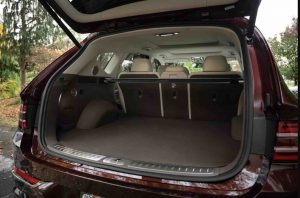
But there’s nothing behind the rear in the G80 – except for a small-for-its-size (13.1 cubic foot) trunk vs. the 34.9 cubic feet of space behind the GV80’s second row, which can be expanded to 84 cubic feet with the second row folded.
And there’s that third row, opening up space for seven people to ride in the GV80 vs. the maximum of five that can fit inside the G80 – which is slightly longer overall (196.7 inches) than the GV80 (194.7 inches).
You can fit more in the GV80 – and it takes up less space in the garage.
This isn’t to say the GV80 isn’t a nice car. It is saying the GV80 is the more practical car.
All trims come standard with a completely digital main and 14.5 inch (length) secondary touchscreen, the largest (widest) available in the class. All trims also come with at least a 12-speaker stereo – with a truly epic 21 speaker Lexicon rig available optionally.
Both offer the very latest in tech, too – including an available 12.3 inch main gauge cluster and Hyundai’s keyless and fobless entry/ignition system. Instead, there’s a card you keep in your wallet – or an app you download to your phone. You can use either to get in – and start – your GV80, without having to fumble for a fob or carry the thing around in your pocket.
On the downside, if you want a heated steering wheel, or the panorama sunroof, you’ve got to buy either the Prestige package or AWD – which ups the MSRP by about $3,900-$5,750 respectively.
And if you want a third row, you’ll have to buy the Advanced+ trim, which ups the MSRP by almost $15k. They are the most expensive seats in the house.
The Bottom Line
You coulda had a V8 – as the old commercial used to say. But it’s not something you’ll miss much in this case.
. . .
Got a question about cars, Libertarian politics – or anything else? Click on the “ask Eric” link and send ’em in!
If you like what you’ve found here please consider supporting EPautos.
We depend on you to keep the wheels turning!
Our donate button is here.
If you prefer not to use PayPal, our mailing address is:
EPautos
721 Hummingbird Lane SE
Copper Hill, VA 24079
PS: Get an EPautos magnet or sticker or coaster in return for a $20 or more one-time donation or a $10 or more monthly recurring donation. (Please be sure to tell us you want a magnet or sticker or coaster – and also, provide an address, so we know where to mail the thing!)
My eBook about car buying (new and used) is also available for your favorite price – free! Click here. If that fails, email me at EPeters952@yahoo.com and I will send you a copy directly!


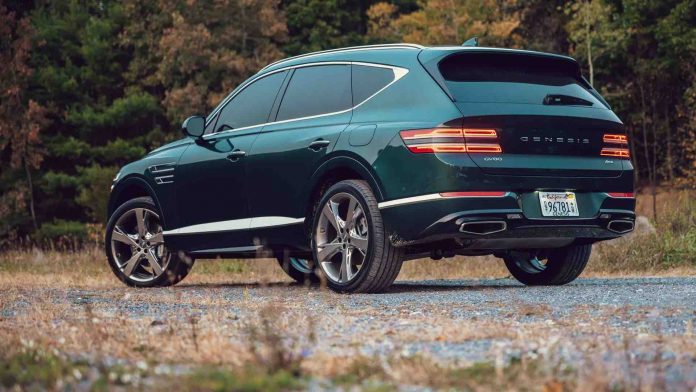

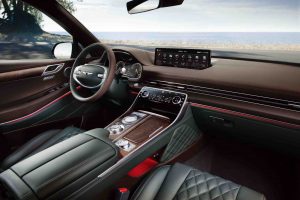
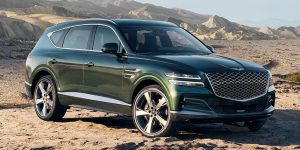
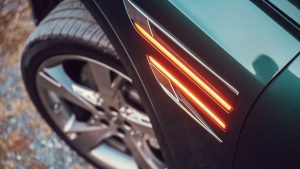









However, there is more bureaucrap money to be made by selling more expensive parts and services, which attract sales taxes. Plus the greater cost of these cars nets more tax money for the governments. And now with all the scameras there is additional money to be made in the form of speeding tickets.
Smaller displacement turbo engine phenomenon is for China and other foreign market where the governments tax the vehicle by the engine size.
What distinguishes these things anymore?
RWD is nice & the towing capacity is surprising, but who is towing with a “luxury” branded vehicle?
“Which is about what V8s in the 4.6 liters range were delivering about ten years ago. Maybe a little better – on paper – but not much”.
There is overpressure in the cylinders when the exhaust valves open. In other words, some pressure (i.e. energy) is wasted when opening the exhaust valves. A turbo, however, is utilizing the pressure (i.e. energy) that is otherwise lost in the exhaust gases. Thus, theoretically speaking a turbo more or less precompresses the combustible mixture for free. Again, theoretically speaking an engine with a turbo should have a better efficiency than an engine without, at least with today’s electronic controlling.
This applies at least to diesel engines, but perhaps to a lesser extent to gasoline engines. I have not tested side by side. Somebody should test the same model under the exact same conditions, with and without turbo and with comparable power, to determine once and for all which concept is more efficient overall. This is a interesting technical issue, and I am looking forward to getting an objective answer sometime.
Hi Jone,
There is no such thing as a free lunch…
There is the literal cost of the turbo itself – and related peripherals, including (usually) an intercooler, specialized exhaust plumbing and various odds and ends. Is the cost of all that – initially, in terms of the greater cost of the turbocharged engine to buy and then eventually, when the turbocharged components fail/require replacement – worth the putative efficiency gains? I doubt it.
Turbos make great sense as power-adders in performance cars, where cost is a secondary consideration and making more power is the primary consideration. Today, turbos are being resorted to as a way to maintain the power otherwise lost to engine downsizing, done for political considerations. There is no sensible case to be made for replacing a simpler, lower-cost/inherently more reliable/durable and longer-lived V8 or V6 with a turbocharged four.
Turbo engines inherently do more work, just think about it.
A naturally aspirated engine compresses ambient air in the cylinders, and pushes some out the exhaust, losing some overpressure, as Jone said.
A turbo engine must compress ambient air, which is work an N/A engine doesn’t do, then the cylinders compress the more pressurized air, which is more work. Some of the overpressure is reclaimed by the turbo, but turbos also create more back pressure for the engine to work against. The upshot is that you can get far more power from the same displacement, and you can also increase thermodynamic efficiency, but does this efficiency gain offset all the extra work?
Since everybody now is offering small engines with turbo, instead of larger naturally aspired engines, I would suppose that smaller engines with turbo are somewhat more fuel efficient at realistic driving conditions. I do not think that the advantage is very large. Yet, I do not see any reason for car manufacturers to deliberately offer engines with lesser fuel efficiency.
I actually have never seen any large car magazine test side by side the fuel efficiency of exactly equally powerful engines with and without turbo. This should be done to settle the discussion.
Besides from that, everything you write above is correct. Thank you for moral support.
Hi Jone,
“Offering”is not the right – the accurate – word. The car industry is being effectively forced to “offer” them by regulations that impose huge costs on them for “noncompliance” with the various “mandates.”
It’s silly – because there is no advantage to the buyer – of putting a more expensive/more complex/probably less durable four cylinder turbocharged engine in a large vehicle rather than a V6 that makes the same power without a turbo.
However, there is more bureaucrap money to be made by selling more expensive parts and services, which attract sales taxes. Plus the greater cost of these cars nets more tax money for the governments. And now with all the scameras there is additional money to be made in the form of speeding tickets.
OL, very good. In my biz, I teach about ‘work’ all the time. When I break down the fundamentals of ‘work’ to my customers, most get it.
When you need to do ‘this’, here are your options, small-high speed cheaper but less reliable, larger-slower much better but more $.
Same same for ICE. But I don’t see a way around this EPA and world ridiculous current state of affairs. I still believe it is all by design to keep already engineered 90’s tech cars from our marketplace.
“Power-folding rear seat.” That’s one way to shut the kids up.
Hi Ross!
I’m not personally a fan of power folding seats or liftgates; but then, I’m not disabled or lazy. I think these features are largely gimmicks, unless a person is disabled or lazy. How hard it is, really, to lift a gate manually? In fact, it is easier – faster – because you can just open and close it. With power – for saaaaaaaaaaaaaaaaaaaaaaaaafety! – the thing raises and lowers at a disabled rate, wasting time and adding exasperation.
When Hyundai debuted in the US market 35 years ago, a first negative impression was that its italic ‘H’ logo is a brazen knock-off of Honda’s upright “H’. Hard to believe that Honda’s asleep-at-the-wheel trademark attorneys didn’t frog march Hyundai into a US court and rip its smirking copycat face off.
Naturally, Hyundai followed in the footsteps of its Japanese mentors Honda (Acura) and Toyota (Lexus) by launching its own luxury division, Genesis. Makes sense from a branding standpoint. But it’s oh-so-predictable.
After Tiger Woods’ possibly Ambien-induced wreck in Rancho Palos Verdes, the GV80 will forever be distinguished as ‘totaled by Tiger’: drives like a dream, crashes like a pillow.
Your MDBC (Mean Distance Between Crack-ups) may vary.
wow, me likes, because of the RWD. However, I still think the Grand Cherokee and it’s new L version will be the car to beat assuming this Genesis is considered a mid-size, can’t tell?
From what I’ve seen, the new GC and GC-L are still going to come with the old tried and true V6 and V8 (non-DI, non-turbo). Yes!
Can’t wait for a review on the new GC Eric, hopefully non-L version, as that’s what we like here. V8 preferred. Don;t care about a few mpg’s.